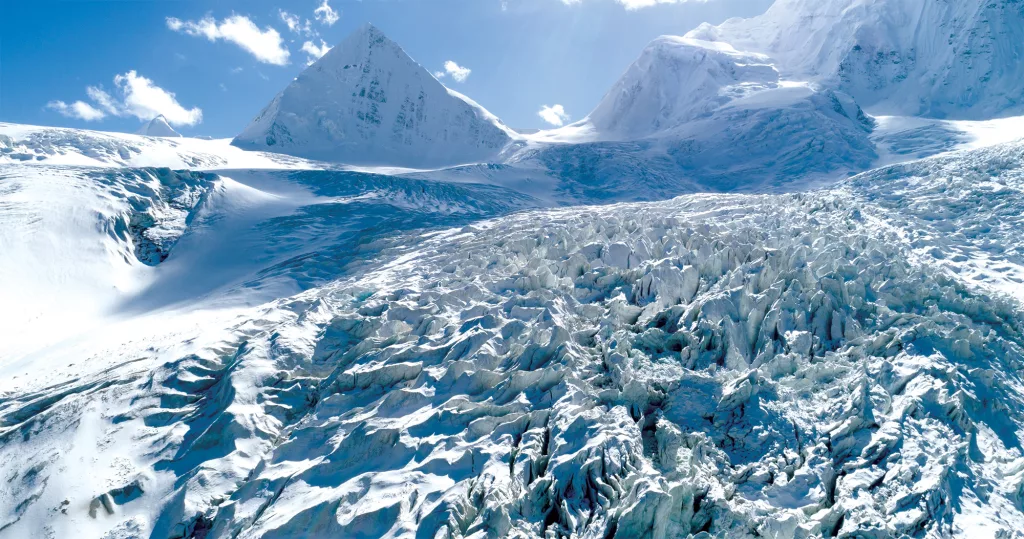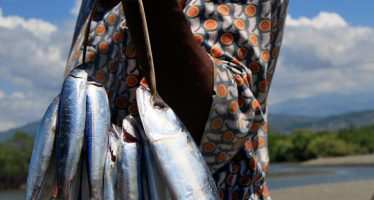Asian Development Bank – Freezing the Impact: Tackling Glacial Melt with Resilient Solutions
Glacial melting threatens regional water security, ecosystems, and economies. Countries must prioritise low-carbon, climate-resilient development through sustainable solutions such as nature-based systems, renewable energy, and diversified financing to manage risks and sustain development.
Glaciers are essential to the climate, ecological balance, cultural heritage, and socio-economic development of the Asia Pacific region. Glaciers not only provide a continuous water source for rivers, unaffected by seasonal changes and rainfall variability, but also reflect excess heat back into space, keeping regional temperatures cooler. Their cold runoff regulates downstream water temperatures and local weather patterns. Additionally, glaciers form natural reservoirs known as glacial lakes, which further help regulate river systems.

Tibet, China: Aerial view of fossil glacier
In many parts of Asia, glaciers and glacial lakes are more than natural wonders; they hold cultural and religious significance, symbolising power and dignity. Many people in this region depend on glacial meltwater for drinking water, agriculture, and hydropower, underscoring the interconnectedness of water, food, and energy.
For instance, Himalayan glaciers feed major rivers like the Indus, Ganges, and Brahmaputra, vital for over 750 million people. In Central Asia, melting glaciers play a crucial role in irrigation, providing nearly half of the annual runoff during the farming season. The region is home to some of the world’s largest and most significant glacier systems, primarily in the Himalayan, Karakoram, and Tien Shan mountain ranges. Covering approximately 100,000 square kilometres, these glaciers are retreating at an alarming rate of 50 metres per year—over twice the rate recorded before 2000—demonstrating the profound impacts of climate change.
Currently, there are about 30,000 glacial lakes across these glaciers, with a total water surface area of roughly 1,500 square kilometres. Rapid glacial melting has led to a 20 percent increase in the number of glacial lakes and a 36 percent increase in their surface area since 2015. Projections suggest that by 2100, the area of glacial lakes in the region could double, with their water volume potentially increasing more than tenfold. The accelerating melt and expansion of these lakes heighten the risk of glacial lake outburst floods, posing a serious concern for the region.
This rapid glacial melting threatens water supplies, ecosystems, and economies, especially in countries reliant on hydropower, river irrigation, and stable water resources. Economic impacts include increased flooding, reduced water availability, and risks to agriculture, energy production, and power supply chains, which could severely disrupt the water, food, and energy nexus.
The consequences are already evident: avalanches and glacial lake outburst floods have caused significant damage in Nepal and India, highlighting the dangers facing downstream communities and infrastructure. Furthermore, glacial melting accelerates river erosion and sediment accumulation, reshaping landscapes and threatening human settlements. Excessive sediment has altered river courses in Bangladesh’s deltaic plains, while biodiversity loss from glacier decline is disrupting local ecosystems. Failure to address these risks could lead to regional conflicts, underscoring the urgent need for action.
Collaborative Solutions for Resilience and Sustainability
To mitigate these risks, countries in the region should collaborate on data sharing, joint monitoring, and risk mapping to strengthen resilience against glacial melting. Long-term water scarcity can be alleviated by improving water storage, enhancing efficient irrigation practices, optimising renewable energy use, and adopting soil and water conservation techniques. Developing climate-resilient crops and diverse agricultural value chains will further help manage the economic impacts of climate change.
Nations need to assess the risks of glacial melting to effectively implement integrated river basin management and relocate infrastructure from high-risk areas. Engaging local communities and the private sector in adaptation strategies, linking glacial melt to water diplomacy, and exploring economic diversification options—such as hydropower revenue, regional water trade, and materials trading—are essential to maintaining development and promoting regional stability.
Financing for Resilient Infrastructure
Securing the necessary financing and investment requires countries to prioritise resilient infrastructure to manage risks from glacial melt and lake outbursts. This includes constructing lake drainage systems, building check dams to stabilise sediment in upper watersheds, creating spillways to divert excess water, and deploying real-time early warning systems.
Investing in risk-informed, climate-resilient, multipurpose infrastructure is critical, with a focus on nature-based solutions and protecting downstream investments through supportive upstream infrastructure. Adapting irrigation and hydropower operations to account for changing water flows and redesigning water management systems are also important considerations. Raising awareness and building local capacity for adaptation, including diversifying livelihoods, are vital for sustainable development and resilience.
Many countries in the region have not yet recognised glacier regions and river basins as regional public goods, which is essential for securing funding to safeguard socio-economic progress. Innovative financing mechanisms such as eco-compensation, environmental trading, carbon markets, and blended finance should be explored. Additionally, risk retention and transfer strategies, including disaster facilities and insurance, can enhance financial stability. The private sector’s role as a service provider, investor, and financing partner is equally crucial.
A Call for Regional Collaboration and Proactive Investment
The accelerating glacial melt in the Asia Pacific region is a stark reminder of the wide-reaching impacts of climate change, threatening not only local water supplies and ecosystems but also the stability of entire economies. The solution lies in regional collaboration, proactive investment in climate-resilient infrastructure, and innovative financial strategies. By working together to address these challenges on a larger scale, countries can build a sustainable future that balances economic growth with environmental protection.

By Rabindra P Osti Principal Climate Change Specialist at ADB’s Climate Change and Sustainable Development Department
The views expressed are those of the author and do not necessarily reflect the views of the Asian Development Bank, its management, its Board of Directors, or its members.
You may have an interest in also reading…
New Cause for Celebration on Biodiversity and Conservation
Experts and enthusiasts in biodiversity and conservation have been collaborating for years to curb humanity’s destructive practices and accelerate positive
Implementing the UN SDGs: A Job for Everyone, Everywhere
Everyone seems to agree that the UN Sustainable Development Goals (SDGs) make perfect sense. Countries and companies, individuals and industries
NEPAD: Boosting Africa’s Most Valuable Renewable Natural Assets – Fish
Sierra Leone’s fisheries sector, valued at 735 million US dollars, has received a boost from the Partnership for African Fisheries



















































































